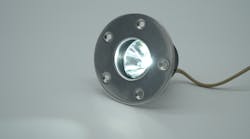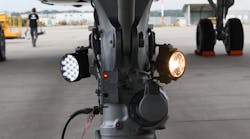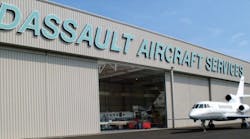From navigation, taxi and landing to anti-collision, cargo, service, wheel well and more, the list of exterior lighting systems for commercial aircraft is expansive — and for good reason. An aircraft’s exterior lighting is critical to operational safety. So, what are the latest lighting technologies keeping travelers safe today and what do top providers in this market see as the next big thing?
“Exterior lighting technology has evolved over time from halogen, xenon and fluorescent to LED,” said Brandie Maxwell, lighting product director for Honeywell Aerospace. “LED was first introduced in position lights in the early 2000s and today the industry continues to experience advances in LED technology with LEDs becoming more and more efficient.”
Jérôme Rame, general manager for Safran Electronics & Defense Cockpit Solutions, cites several factors that have made LED technology the industry standard for exterior lighting today, including “optical performance, power consumption, reliability and maintenance costs,” he said. “In addition, LED offers the following possibilities: combination of several functions in one light for external lights, simplification of the dimming capabilities and optimization of the integration.”
“The LED luminous efficacy, or lumens per watt, has made significant advances over the last few decades,” said Steve North, business development manager for Oxley, Inc. “Twenty years ago, a substantial number, even hundreds, of LEDs were needed to provide enough light to replace a typical navigation or anti-collision light filament bulb or xenon flash tube. Today, fewer than 10 LEDs can replace a flash tube and two LEDs can replace a filament bulb navigation light.”
Andre Hessling, senior technical fellow for Collins Aerospace, sees the technology advancing as well, with lights becoming smaller, easier to integrate and smarter in terms of their ability to predict maintenance needs, track changing environmental conditions and adapt to them.
What’s driving innovation today, he says, “is a deep understanding of what the industry wants to achieve, which is improving the pilot’s vision in adverse weather conditions. More light is not always better. If you are driving through heavy fog, you don’t turn on the high beams. So, we are focused on improving safety through smart application of lighting.”
Migrating to Longer-Lasting LEDs
While it is standard practice today to equip new production aircraft with external LED lighting systems, the majority of fielded aircraft still operate with legacy exterior lights.
“Without question, the legacy lighting technology, incandescent and xenon, are largest by number of installations simply based on the number of years they have been in service,” said Ryan Edmark, director of sales for AeroLEDs. “However, by new production aircraft standards, it is LED-derived lights that own the majority.”
Maxwell added, “The upfront cost of halogen lights is low and it’s easy to find quick replacements. But LEDs require lower power to perform the same functions with a longer life — of 10 to 100 times — and in some cases at a lower weight.”
There are still use cases for halogen lights, though, on commercial aircraft. “In environments with extreme temperatures that exceed 130 degrees, for example, LED is not the right solution,” said Hessling. “Halogen is not as temperature sensitive.”
And xenon lighting systems have their place in the market. “Xenon lights are longer lasting than halogen bulbs,” said Hessling. “They are starting to phase out, though, because they are complex to operate and hard on equipment.”
Rame sees end users looking to retrofit halogen products with mature LED products. “This trend will continue to grow over the coming years,” he noted.
To meet the demand for more advanced technologies, Honeywell offers drop-in LED replacements for legacy halogen lighting which are easy to maintain. “Customers tell us that their requirements are to fulfill the same function as legacy halogen lighting, but they are seeking ways to keep maintenance costs and effort low and also improve on-wing reliability and aircraft availability,” explained Maxwell.
As noted by Edmark, an operator’s selection of exterior lighting systems often comes down to cost. “It starts and ends with pricing and return on investment (ROI),” he said. “Most customers are wanting a minimum two-year ROI.”
North added, “Reducing or eliminating maintenance involved in replacing bulbs can offer significant cost savings. Replacing traditional filament bulbs on a commercial fleet is one of the top three aircraft maintenance costs.”
Regardless of the technology, commercial aircraft exterior lighting is subject to a host of industry standards, emphasizes North, including those “driven by Federal Aviation Administration regulations, RTCA DO-160 and SAE Aerospace Recommended Practice (ARP) guidelines.”
Going Green
As is the case across virtually every industry today, the commercial aircraft industry is implementing more sustainable business practices and technologies.
To that end, North points out that modern LED exterior lighting systems are highly sustainable. “From an environmental standpoint, the power savings that can be achieved are massive,” he said.
“Sustainability is coming into focus,” said Hessling. “We have operators in countries like Denmark and Singapore which are ahead of others and ask us how we are improving our footprint year over year to become more sustainable. In Europe, we see this every day.”
Collins Aerospace has responded by removing chrome contents from its coatings, delivering a prolonged lifespan for lighting systems and enhancing other attributes of its LED lighting solutions to improve their sustainability.
Intelligent Lighting, Safer Flights
While sustainability is a concern for operators, the industry remains primarily focused on optimizing the performance of exterior lighting systems.
For example, Oxley has worked with many aircraft manufacturers to integrate the lighting systems into aircraft Crew Alerting Systems (CAS) to provide health monitoring and any error reporting, according to North.
To expand functionality for customers, Collins Aerospace offers integrated LED lighting systems driven by intelligent technologies. “Our lights today are designed for bad weather penetration and to increase the visibility of what is in front of the pilot,” said Hessling. “Bright light can overwhelm.”
Dana Troutman, engineering director for Collins Aerospace, added, “We are working a lot with artificial intelligence as a diagnostic tool to improve the reliability, performance, safety and life-cycle costs of exterior lighting.”
The company’s newest LED lighting systems are technologically equipped to track changing environmental conditions and adapt to them automatically. To demonstrate this capability, Collins Aerospace invites customers to test the company’s exterior lighting systems via a virtual reality suite that simulates adverse conditions such as heavy rain.
“Using this system, the end user makes a standard approach and then we may randomly place a truck, for example, on the virtual runway,” said Hessling. “This allows us to measure the time it takes for the pilot to recognize the object and avoid the landing.”
COVID’s Impact
While LED lighting technology is advancing quickly, the COVID-19 pandemic and associated global slowdown in air travel have had their impact on the industry.
“Production has been affected,” said Troutman. “However, while we have been in this phase, we have moved ahead with technological developments. For example, for our line of interior lighting systems, we have been working with academic teams to research UV sterilization lighting.”
Edmark notes that the exterior commercial lighting market has experienced similar impacts from the pandemic as other aerospace markets. “With commercial flights being down more than 40 percent, consumption of lighting followed the same path,” he said.
Maxwell adds that some areas of the industry have fared better than others. “Cargo carrier and military demand has remained stable,” she stated.
Looking Ahead
In the future, Maxwell expects to see, in the near term, continued proliferation of LED lighting in fielded aircraft. “Further out on the horizon, we can anticipate advances in both solid-state lighting and lighting connectivity,” she said.
Edmark also predicts continued demand for LED lighting.
“LEDs still own the majority of innovative technology and will continue to increase their saturation of the market in the future as they increase their power efficiency,” he said.
Hessling added, “LED is here to stay, as are sensors, software, human-centric lighting and integration. We also see the automotive industry driving new design trends, giving the aircraft a signature appearance. And there is a new generation of high-speed supersonic aircraft on the horizon that will require a different kind of lighting.”
With so many changes happening in the industry so quickly, one defining factor remains. “The aerospace industry cannot compromise on safety,” noted Hessling. “We fly because we believe we will arrive at our destination. What I have seen, year over year, is higher safety standards. Going forward, raising the standards for equipment and performance levels will continue to be the single biggest contributor to aircraft safety.”




